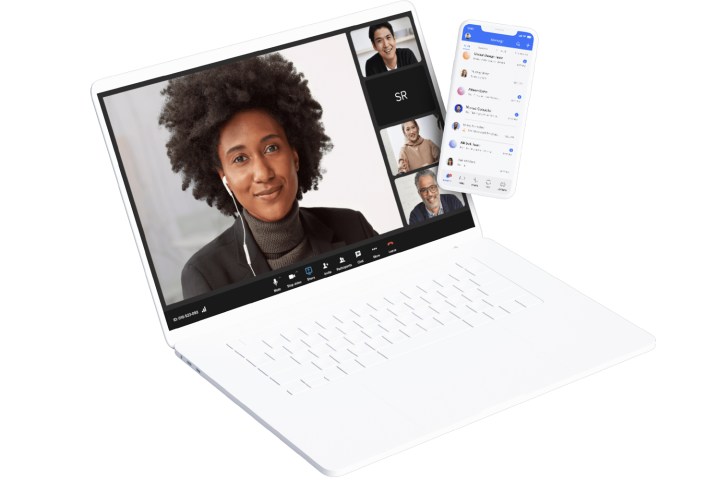When running a small business, it’s vitally important that you find the best services for your everyday needs and at the best value price too. That’s why in the past, we’ve looked at the best VPN services as well as the best firewalls for small businesses amongst many other subjects. In recent times, videoconferencing software has become more important than ever due to the rise in remote working.
While the best videoconferencing software for small businesses can help a lot, it’s also important to invest in specific infrastructure for doing things if you’re looking for a long-term solution.
That’s why we’re looking at two of the biggest names out there right now — RingCentral and Zoom. Both offer comprehensive video conferencing platforms for businesses but each offers its own set of pros and cons. To help you figure out the best way for your business to stay connected virtually, read on while we take you through everything both services provide and evaluate which is the best option for your needs.
What features does RingCentral offer?

RingCentral prides itself on being an extensive platform for small businesses. It combines messaging, videoconferencing, and phone capabilities all in one to save the need to switch between different services.
One of the key components of RingCentral is that it allows you to invite up to 200 participants to a meeting. For a small business, that might not always be essential but it’s useful to know that the service can expand along with your future plans.
In all cases, the clarity of a RingCentral video call is remarkable. It offers full HD audio and video so providing your internet connection can cope, you’re guaranteed crisp video and a clear call. It’s possible to password protect meetings too ensuring comprehensive security each step of the way. Virtual backgrounds are also possible for those that want to hide their surroundings.
At its simplest, RingCentral is ideal for a small business because it genuinely takes minutes to set up thanks to the easy-to-use RingCentral app. You can start taking phone and video calls from any device, choosing to keep your current number, or opting to purchase your own local, global, or toll-free number. Whatever works for your business is an option here. Besides making calls, it’s simple to share your screen too for collaborative purposes.
Thanks to its simplicity, that also means you won’t have to worry about IT overheads as you can manage everything from one app yourself. RingCentral also offers real-time analytics for phone and meetings so you can see all the system activity in a single pane while tracking and reporting service quality and other key performance indicators.
It’s similarly simple to deploy new users and even entire offices with everything only a couple of button presses away. RingCentral integrates neatly with hundreds of other apps too such as Microsoft 365 and Google Workspace so you’re never left hanging.
If you want to expand to a PBX phone system, there’s support for more than 40 countries too with RingCentral offering a virtual presence in over 80 countries so it’s ideally suited for an international business.
What features does Zoom offer?

Zoom has had a meteoric rise in recent times with everyone from small businesses to individuals giving it a shot during the remote working era. The company has a sliding scale of different features and products so it can grow with your business needs.
At its simplest, there’s Zoom Meetings which makes it very easy to set up video conference calls on pretty much every device imaginable. A quick email with a link ensures that even the least tech-savvy client or customer can figure things out. Zoom Meetings syncs with your calendar system so you won’t miss out on a call either. Like RingCentral, there’s passcode protection along with waiting room options to ensure that the call is always secure.
HD video and audio are available here with support for up to 1,000 video participants and 49 videos on screen. Generally, Zoom calls are very reliable and provide high rates of clarity too. It’s possible for multiple participants to share their screens simultaneously as well as co-annotate for more interactivity.
Zoom also offers the option to record your meetings locally or to the cloud with searchable transcripts, as well as a 10-year archive for team messenger chats. Engaging features such as polls, reactions, and hand raises add to the more collaborative experience than simply taking a call.
Much like RingCentral, Zoom also offers detailed analytics for post-meeting analysis, plus there’s the usual bevy of extensive integrations with other key apps your business requires.
How much does RingCentral cost?
RingCentral pricing varies depending on your business needs.
At its cheapest, there’s RingCentral Video Pro which is entirely free for video meetings and team messaging. It offers unlimited meetings for up to 100 participants so it’s ideally suited for small businesses. There’s the option to instantly join in the browser with cloud recordings stored for up to seven days. Extensive integrations are catered for including Google Workspace, Microsoft Teams, and office 365. It’s also possible to share files and manage tasks.
Alternatively, if you need to host more people, RingCentral Video Pro+ costs $15 per user per month and hosts up to 200 participants. Cloud recordings can be stored for up to a year, advanced analytics are provided, plus there’s single sign-on support. You can call any phone from a meeting too with 500 minutes included per user, plus there are popular business integrations such as Salesforce.
RingCentral MVP is the other option that provides messaging, video conferencing, and phone services from $25 per user per month. There’s no limit on the number of users with unlimited internet fax, unlimited audio conferencing, video meetings with up to 100 participants, and business phone number options in over 100 countries.
How much does Zoom cost?
Like RingCentral, Zoom offers a free plan. The basic package allows you to host up to 100 participants with unlimited group meetings for up to 40 minutes. There are unlimited one-on-one meetings with no time limit too, along with private and group chat.
For small businesses though, the Pro package is a better offer at $15 per month per license with the option to increase participants to 1,000 with the Large Meetings add-on plan. Group meetings can last for up to 30 hours with social media streaming an option and 1GB of cloud recording too.
The Business package is $20 per month per license and offers the same benefits with up to 300 participants, recording transcripts, managed domains, company branding, and single sign-on functionality.
Finally, there’s the Enterprise plan at $20 per month per license with all the benefits of the Business package plus the ability to host up to 500 participants and unlimited cloud storage.
RingCentral vs Zoom: Which is best for small businesses?
Both RingCentral and Zoom offer very useful features for any small business looking to expand their video conferencing and collaboration features.
Ultimately, we think Zoom is a little more user-friendly to set up if you simply want to arrange some calls with colleagues or potential clients but RingCentral has the benefit of providing the best VoIP services too. If you’re looking to make it easier for your business to communicate with clients through more traditional ways then RingCentral has the edge here. Plus, the app-based service means it still doesn’t take long to set up, no matter what your plans are.
For a slightly friendlier experience that feels a bit more like other team messaging services such as Slack or Microsoft Teams, Zoom has the edge thanks to its reaction system and so forth, but it all comes down to what kind of vibe your business is aiming for.
Whichever you choose, both RingCentral and Zoom offer high levels of reliability and excellent security. In the past, Zoom was known for some security issues but it’s quickly fixed such issues ensuring it’s a worthy rival to the slightly more established RingCentral.



